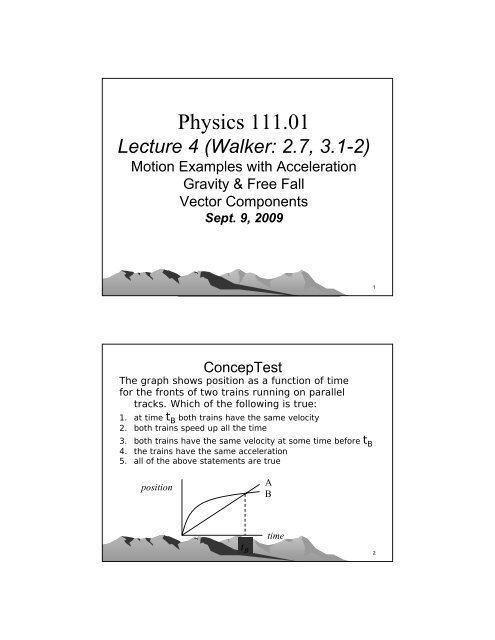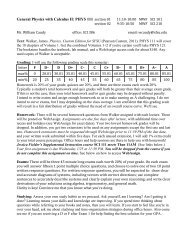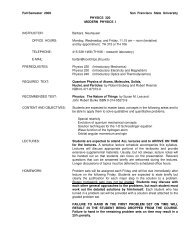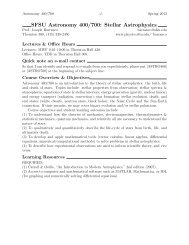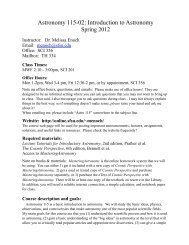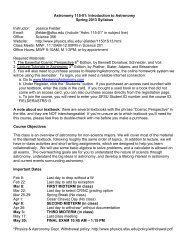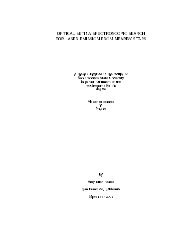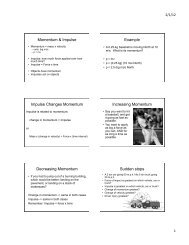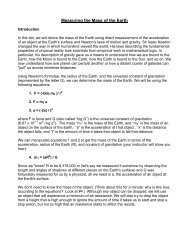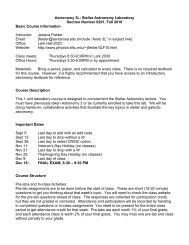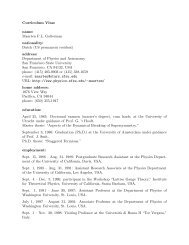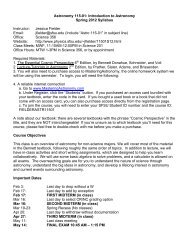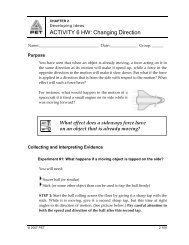Lecture 4 Notes (PDF) - SFSU Physics & Astronomy
Lecture 4 Notes (PDF) - SFSU Physics & Astronomy
Lecture 4 Notes (PDF) - SFSU Physics & Astronomy
Create successful ePaper yourself
Turn your PDF publications into a flip-book with our unique Google optimized e-Paper software.
<strong>Physics</strong> 111.01<br />
<strong>Lecture</strong> 4 (Walker: 2.7, 3.1-2)<br />
Motion Examples with Acceleration<br />
Gravity & Free Fall<br />
Vector Components<br />
Sept. 9, 2009<br />
1<br />
ConcepTest<br />
The graph shows position as a function of time<br />
for the fronts of two trains running on parallel<br />
tracks. Which of the following is true:<br />
1. at time t B both trains have the same velocity<br />
2. both trains speed up all the time<br />
3. both trains have the same velocity at some time before t B<br />
4. the trains have the same acceleration<br />
5. all of the above statements are true<br />
position<br />
A<br />
B<br />
t B<br />
time<br />
2
Problem Solving Strategy for 1-D 1 D Motion<br />
with Constant Acceleration<br />
<br />
<br />
Picture - Determine if problem is asking you to find time,<br />
distance, velocity, or acceleration for an object.<br />
Solve - Use the following steps to solve problems that<br />
involve 1-D motion and constant acceleration:<br />
1. Draw figure showing particle in initial and final positions.<br />
Include coordinate axis and label initial and final coordinates<br />
of the position.<br />
2. Select one or more of the constant-acceleration kinematic<br />
equations. Solve them algebraically for the desired<br />
quantities, then substitute in given values & evaluate answer.<br />
3. Repeat as needed.<br />
Check - Make sure your answers are dimensionally<br />
consistent and are in the expected “ballpark”.<br />
3<br />
Problem 63, , Walker Chap. 2<br />
A model rocket rises with constant acceleration to a height<br />
of 3.2 m, at which point its speed is 26.0 m/s.<br />
(a) How much time does it take for the rocket to reach<br />
this height?<br />
(b) What was the rocket's acceleration?<br />
(c) Find the height of the rocket 0.10 s after launch.<br />
4
Solving the problem<br />
• What is known<br />
X f = 3.2 m<br />
V f = 26.0 m/s<br />
Assuming<br />
v 0 = 0 m/s<br />
x 0 = 0 m<br />
x<br />
a<br />
v<br />
To be determined:<br />
(a) t f – time it takes rocket to reach the height x f<br />
(b) a – the rocket’s acceleration<br />
(c) x (t=0.1s)<br />
5<br />
Solution<br />
Starting equation<br />
1 x f<br />
= x<br />
0<br />
+ v<br />
0 t + at<br />
2<br />
v<br />
f<br />
v f<br />
= at a =<br />
t<br />
1<br />
x<br />
f<br />
= v<br />
f<br />
t<br />
2<br />
Part (a)<br />
2x<br />
t =<br />
v<br />
f<br />
f<br />
2<br />
6.2m<br />
=<br />
26m<br />
/ s<br />
Part (b)<br />
v<br />
f<br />
a =<br />
t<br />
Part (c)<br />
1<br />
x(<br />
t = 0.1s)<br />
=<br />
2<br />
= 0.5•<br />
108.3m<br />
/ s<br />
= 0.24s<br />
26m<br />
/ s<br />
= = 108.3m<br />
/ s<br />
0.24s<br />
at<br />
2<br />
2<br />
•(0.1s)<br />
2<br />
2<br />
= 0.54m<br />
6
Example: Hit the Brakes!<br />
Man driving at velocity v 0 suddenly sees stopped truck<br />
200 m ahead. He applies brakes and slows with an<br />
acceleration of -10 m/s 2 , just missing truck. What was v 0 ?<br />
How long did it take to stop?<br />
a= -10 m/s 2<br />
v 0<br />
x<br />
x 0 =0<br />
200 m<br />
7<br />
v<br />
2<br />
= v<br />
2<br />
0<br />
+ 2a(<br />
x − x0<br />
)<br />
0=v<br />
2 0 + 2(-10 m/s 2 )(200m)<br />
v 02 = 4000 m 2 /s 2<br />
v 0 = 63 m/s = 141 mi/h<br />
Time to stop?<br />
v = v 0 + at<br />
0 = 63 m/s + (-10 m/s 2 ) t<br />
t = 6.3 s<br />
8
Free Fall<br />
• Objects moving under the influence of only the<br />
force of Earth gravity are said to be in free fall<br />
• Force of Earth gravity on object of mass m<br />
located near surface of Earth has size mg and a<br />
direction pointing toward the center of the Earth<br />
(i.e., downward)<br />
• g = 9.80 m/s 2 = 9.80 N/kg<br />
• Newton’s Second Law says acceleration of mass<br />
m produced by force of size F is given by a = F/m<br />
with the same direction that the force has<br />
• The amount of acceleration of a mass m<br />
produced by a force of size F = mg would be<br />
a = F/m = (mg)/m = g.<br />
9<br />
Acceleration Due to Gravity<br />
•All objects in free fall near the earth’s surface fall<br />
downward with a constant acceleration g = 9.80 m/s 2<br />
(called the acceleration due to gravity)<br />
• g is always directed downward<br />
– toward the center of the earth<br />
At San Francisco<br />
g = 9.80 m/s 2 .<br />
If downward is designated<br />
as the +y direction, then a<br />
= +g; if upward is<br />
designated as the +y<br />
direction, then a = -g.<br />
(Note that g is always a<br />
positive number, but a<br />
may have either sign.)<br />
10
Falling Objects in Air<br />
An object falling in air is subject to air resistance<br />
(and thus is not freely falling). Amount of air<br />
resistance depends on shape & size.<br />
11<br />
Free Fall --Object Dropped<br />
• Initial velocity is zero<br />
• Frame: let up be positive y<br />
• Use the kinematic<br />
equations<br />
– Generally use y instead<br />
of x since vertical v o = 0<br />
1 2<br />
y = at<br />
a = - g<br />
2<br />
a = −9.8m<br />
s<br />
2<br />
y = −(4.9m<br />
/ s<br />
2<br />
) t<br />
2<br />
a<br />
x<br />
12
v = -<br />
y =<br />
y = -<br />
v = -<br />
y = -<br />
Free fall from rest:<br />
y<br />
v= -<br />
y = -<br />
v= -<br />
y = -<br />
13<br />
Free Fall --Object Thrown Downward<br />
• a = - g<br />
– With upward being positive,<br />
acceleration will be negative,<br />
a = -9.8 m/s²<br />
• Initial velocity ≠ 0<br />
– With upward being positive,<br />
initial velocity will be negative<br />
y<br />
v 0<br />
x<br />
a<br />
14
Free Fall -- Object thrown upward<br />
• Initial velocity is<br />
upward, so positive<br />
• The instantaneous<br />
velocity at the<br />
maximum height is<br />
zero<br />
• a = -g everywhere in<br />
the motion<br />
• a is always<br />
downward, negative<br />
v = 0<br />
15<br />
Thrown upward<br />
• The motion may be “symmetrical” (object<br />
starts and ends at same height)<br />
– then t up = t down<br />
– then v f = -v o<br />
• The motion may not be symmetrical<br />
– Break the motion into various parts<br />
• usually up part and down part<br />
16
Graphical example: A ball is thrown<br />
upward from the ground level.<br />
x = ball’s height<br />
above the ground<br />
Velocity is positive<br />
when the ball is<br />
moving upward<br />
Why is acceleration<br />
negative?<br />
Is there ever deceleration?<br />
17<br />
Object Thrown Upward (Symmetric)<br />
Position-time plot:<br />
Position<br />
Velocity<br />
Acceleration<br />
18
Non-symmetrical<br />
Free Fall<br />
• Need to divide the<br />
motion into<br />
segments<br />
• Possibilities include<br />
– Upward and<br />
downward portions<br />
– The symmetrical<br />
portion back to the<br />
release point and<br />
then the nonsymmetrical<br />
portion<br />
19<br />
ConcepTest 3<br />
A person standing at the edge of a cliff throws one<br />
ball straight up and another ball straight down at<br />
the same initial speed. Neglecting air resistance,<br />
the ball to hit ground below the cliff with greater<br />
speed is the one initially thrown<br />
1. upward<br />
2. downward<br />
3. neither – they both hit at the same speed<br />
20
Example: The Flying Cap<br />
Upon graduation, a joyful student<br />
throws her cap straight up in the air<br />
with an initial speed of 14.7 m/s.<br />
(Neglect air resistance.)<br />
What is acceleration of cap?<br />
(a) When does cap reach its highest<br />
point?<br />
(b) What is the distance to the<br />
highest point?<br />
(c) Assuming the cap is caught at<br />
same height it was released, what is<br />
total time cap was in flight?<br />
1. Draw the cap (as a dot) in its<br />
various positions.<br />
21<br />
2. (a) Use the time, velocity and acceleration relation.<br />
vx<br />
− v0<br />
x<br />
(0 m/s) − (14.7 m/s)<br />
vx = v0 x<br />
+ ax∆t; ∆ t = = = 1.5 s<br />
2<br />
a −9.81<br />
m/s<br />
x<br />
(b) Use average velocity: v av = v 0 /2 = 7.35 m/s;<br />
∆x = v av ∆t=(7.35 m/s)(1.5 s) = 11.0 m<br />
(c) Up time = down time, so total time is 3.0 s. (see text<br />
for a more complicated method.)<br />
3. The answers have the right units and seem reasonable.<br />
22
Fun QuickLab: : Reaction time<br />
d<br />
=<br />
1 2<br />
2<br />
g t<br />
2<br />
t =<br />
, g = 9.8m<br />
2d<br />
g<br />
s<br />
23<br />
2-D Motion - Vectors<br />
Scalar: number with<br />
units<br />
Vector: quantity<br />
with magnitude and<br />
direction<br />
How to get to the<br />
Library: you need to<br />
know how far and<br />
which way to go.<br />
In 2-D, need more<br />
than + & - directions.<br />
24
Vector Notation<br />
• When handwritten, use an arrow: A r<br />
• When printed, may be in bold print: A<br />
• When dealing with just the magnitude of a<br />
vector in print, an italic letter may be used:<br />
A<br />
• Position vector usually written as r<br />
• Displacement vector ∆r<br />
25<br />
The Components of a Vector<br />
You may<br />
accomplish the<br />
displacement ∆r<br />
by making a<br />
displacement ∆x<br />
followed by a<br />
displacement ∆y.<br />
∆y<br />
∆r<br />
∆x is called the “x<br />
scalar component”<br />
of ∆r ; ∆y the “y<br />
scalar component”<br />
∆x<br />
26
Vector Component Notation<br />
A r<br />
is<br />
• The x-component of a vector<br />
usually written as A x<br />
• The y-component is A y<br />
• For position vector r we could write the<br />
x-component as r x (textbook) or just x<br />
• The position vector y-component would be<br />
r y or just y<br />
27<br />
The Components of a Vector<br />
Components can be calculated from the size and<br />
direction angle of a vector, using trigonometry:<br />
A = Acosθ<br />
A = Asinθ<br />
x<br />
y<br />
28
More About Components of a<br />
Vector<br />
• The previous equations are valid only if θ<br />
is measured with respect to the x-axis<br />
• The scalar components can be positive or<br />
negative and will have the same units as<br />
the original vector<br />
• The x-component is the projection of<br />
vector along the x axis; the y-component<br />
the projection of the vector along y axis<br />
29<br />
Key Points of <strong>Lecture</strong> 4<br />
Motion Examples with Acceleration<br />
Force due to Earth Gravity, Newton’s s 2 nd Law, Free Fall<br />
Acceleration due to Gravity, g<br />
Problems Involving Freely-Falling Falling Objects<br />
Vectors and Vector Components<br />
• Before the next lecture, read Walker 3.3-3.6<br />
• Homework Assignment #2c should be<br />
submitted by 11:00 PM on Friday, Sept. 11.<br />
30


